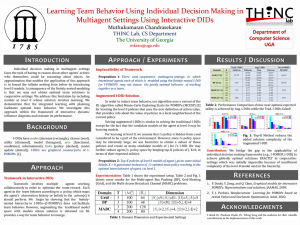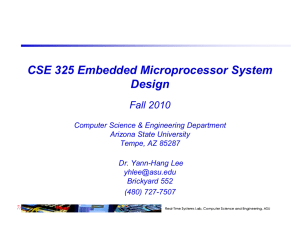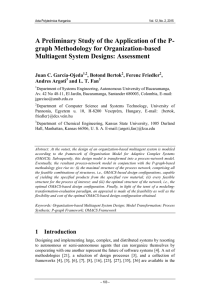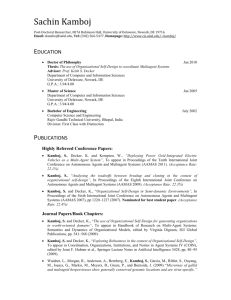ppt - ICAR
advertisement
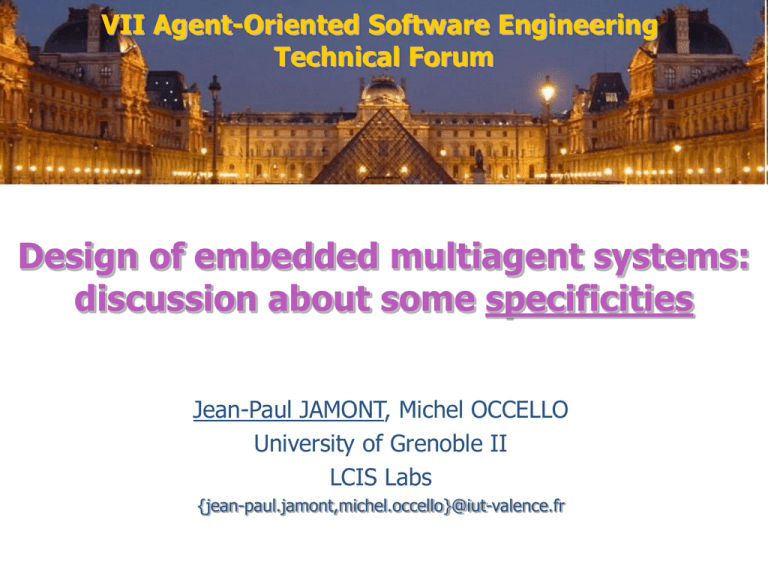
VII Agent-Oriented Software Engineering
Technical Forum
Design of embedded multiagent systems:
discussion about some specificities
Jean-Paul JAMONT, Michel OCCELLO
University of Grenoble II
LCIS Labs
{jean-paul.jamont,michel.occello}@iut-valence.fr
PLAN
INTRODUCTION
I. Lifecycle
II. Specific activities
III. An original eMAS simulation tools
CONCLUSION
2
Introduction :
Embedded Systems
Dedicated systems built to handle one or a few preestablished tasks in interaction with the physical world
As consumer systems their architectures often supply
inexpensive microprocessors and limited storage
2007: 4 440 000 000 8bit c
2010: 6 500 000 000 8bit c
Strong constraints for embedded systems:
application size
interaction with the physical world
response time
power autonomy
3
Introduction :
Cooperative Embedded Systems
More constraints for cooperative embedded systems :
Complexity
Concurrency
Integration or composition of heterogeneous systems and services
Dynamic Reconfiguration
Mobility
Data and function integrity
Embedded software are thus not just software on
small computers.
They are conceived using software built into or
'embedded' within a device. The software can be
partly 'built in' to the electronics.
Specialized hardware architectures as FPGA or SOC
can be used in this context.
4
Introduction :
Embedded Multiagent Systems
Building an embedded MAS doen’t consist simply in
translating agent code to another plateform
Agents of an eMAS :
Own low memory ressources
Own low CPU MHz
Must manages their autonomous energy
16K-32K, stack of 256 bytes
1MHz-4MHz
Sleep/wake up mode…
Embedded features impact design processes, models,
architectures and implementations of the agents
The transposition to a local agent model/architecture
can insert some deviations in the global behavior.
5
Introduction :
Embedded Multiagent Systems
Previous works on embedded multiagent systems
The DIAMOND method [AIAI05]
The MWAC model [IAT07]
Applications:
Wireless measurement systems [Measurement10],
Geolocation [CSTST08]
Cooperative robotics [MARS06]
Decentralized automation systems [CICA11]
6
PLAN
INTRODUCTION
I. Lifecycle
II. Specific activities
III. An original eMAS simulation tools
CONCLUSION
7
Lifecycle
Traditionnal approaches vs hw/sw codesign approach
71.5% of all embedded system designs
were not within 30% of pre-design
performance expectations.
[Embedded Computing Design, Skazinski03]
•
•
•
•
•
Reduced time to market
Best design space exploration
Rapid prototyping
Simplified hw/sw integration
8
…
Lifecycle
Traditional life cycle are waterfall like
MAS : few works on the deployment phase
Gaia [Woolridge 2000], Mase [Deloach 2001]
PASSI [Chella 2004], MASSIVE [Lind 2001]
Necessity of an iterative and incremental approach
[Cernuzzi 2005], Agile-PASSI [Chella 2006]
9
The DIAMOND Life Cycle
partitioning the system in a hardware part and a software part
to produce the code and the hardware synthesis
defines what the user needs and characterizes the global
functionalities
decomposing a problem in a multiagent solution
to build the multiagent system without distinguisting
hardware/software parts
10
PLAN
INTRODUCTION
I. Lifecycle
II. Specific activities
III. An original eMAS simulation tools
CONCLUSION
11
Specific activities
In early requirements
Designing embedded multi-agent systems implies to
treat of extra-functional requirements related to
deployment.
Most multiagent methodologies focus only on functional
requirements whereas designing embedded multi-agent
systems imposes to treat of extra-functional
requirements.
Some of the multiagent leader methodologies attempts
to integrate some techniques to catch extra-funtional
requirements in their last extensions
O-Mase [Harmon09], RE-Gaia [Blanes09] .
12
Specific activities
In early requirements
Another aspect to study, related to the physical context, are the
requirements in terms of safety (physical risk assessment):
the guarantee that the system will not be dangerous for the human user even in degraded
running mode.
Requirements expression from manufacturing systems :
FMEA : Failure modes and effects analysis
a qualitative hazard identification that helps to identify potential failure modes based on past
experience with other systems. The objective is to study the effects of those failures and how
they can affect the user.
HAZOP : Hazard an Operability Studies
The HAZOP approach is a systematic procedure for determining the causes of process deviations
from normal behavior and consequences of those deviations.
[Ebrahimipour10] proposed an agent structure and used it in a multiagent system to ensure safety
engineering by the means of faulty diagnosis diagram trying to solve limitation of FMEA in complex
systems or with a process with numerous components.
[Sterling09] presents safety as a quality attribute for a multiagent system.
A few industrial applications using multiagent have involved some HAZOP rules.
DIAMOND introduces GEMMA
13
Specific activities
Study of running/stop modes
STOP MODE & RESTART MODE
PROCEDURE TO
RETURN IN INTIAL
STATE
RUNNING MODE
STOP IN INITIAL
STATE
NORMAL
STOP STATE
PROCEDURES
NORMAL STOP
IN A SPECIFIED
STATE
PROCEDURE
EMERGENCY MODE
MAS STILL
AUTONOMOUS
RUNNING
STOP PROCEDURE TO ENSURE
SECURITY
MAS IN NORMAL
RUNNING
EMERGENCY TEST
PROCEDURE
DIAGNOSIS OR
FAILURE
TREATMENT
VERIFICATION
PROCEDURE
MAS IN AUTONOMOUS RUNNING
TERMINATION
PROCEDURES
STOP
OBTAINED
START
PROCEDURES
GOING IN A
SPECIFIED
STATE
PREPARATION FOR
RESTART AFTER
DYSFUNCTIONNING
MAS
COMPONENT
VERIFICATION
IN ORDER
14
Specific activities
In the multiagent analysis
Specific properties must be taken into account in multiagent models :
Integration
Safety
Real-Time Capabilities
Power Management
Connexion maintaining
Timeliness
Trust and Reputation
Mobility
Risk Modelling Framework
Integrity
Real world physical interaction
Decision
Interaction
Heterogeneity
Data
Interaction
15
Specific activities
In the multiagent analysis
AIM: decomposing a problem into a multiagent solution
16
Specific activities
Individual step
A model for real world physical interaction integration
17
Specific activities
Socialization of the agents
Identifying and analyzing the possible influences upon the two previous steps.
Those influences are integrated within the agents by means of their
communication and perception assessment capabilities.
18
orders
Values observed
received
parameters of
actions (or of priority of the decides of the
for world
messages and
decision
decision
action
pertinence, of
representation
contents…
(immediately plans (actions)
functions
sequences)
(a given state of
with
able to be
to trigger and of
the world)
triggered after preemption, the emergency
the validation ofafter the current of activation
task, etc...) function of the
evaluation
conditions
state of the
world
19
Specific activities
Generic design
Reducing the gap between analysis and implementation
Building flexible reconfigurable hw/sw framework [Naji04]
Mixing software agents and hardware agents [Meng05]
Building agents using different embedded techniques :
System-on-Chip [Naji06]
Control Theory (PID) [Breemen00]
Labview [Polakow09]
Building agent using generic hw/sw components
20
Specific activities
Generic design
AIM: Building the multiagent system, once one knows what agents have to do
without making any difference between hardware/software parts
• Choosing technological solutions,
• Building agents using components.
INFORMATION
SPECIFICATION
Message to deliver
Bit field (sender id 8b, receiver id 8b, data length 8b, data 0-2048b)
Received message
Bit field (sender id 1b, receiver id 1b, data length 1b, data 0-2048b)
Location request
Falling edge
Flight time
Number of quantum – unsigned integer, 24b
Battery level
Percentage of available energy - IEEE 754, 32b
<location,confidence>
Union – 64bits
X,Y : uint 16b, uint 16b - Shared orthonormal basis
Confidence : IEEE 754, 32b
High level = 5V
Low level = 0V
21
Specific activities
Generic design
22
Specific activities
Implementation
AIM: partitioning the system into a hardware part and a software part to produce
the code and the hardware synthesis
Criteria: cost, performance, flexibility, fault-tolerance, ergonomic
Criteria: cost, performance,
flexibility,
non-functional constraints
constraints
and thefault-tolerance,
algorithmic complexity.
(thermal dissipation, dimension, energy consumption …) and the algorithmic complexity.23
Specific activities
Implementation
24
25
PLAN
INTRODUCTION
I. Lifecycle
II. Specific activities
III. An eMAS simulation tools
CONCLUSION
26
Our Hw/Sw simulator
AIMS
1: enables hw/sw agents society simulation
2: involves realistic models of :
- the physical environment
- the battery consumption
- the wave propagation
27
Traditional ways to design eMAS
Related works
Work of Danny Weyns, Kurt Schelfthout, Tom Holvoet, Tom Lefever
[AAMAS2005]
=> Make a virtual environment from the physical observations to plan actions
• Work of Fawzi Hassaïne, Russ Moulton, Chris Fink [SAC2009]
=> Have more realistic simulations
28
Our Hw/Sw simulator
Overview of MASH
Demonstrated in IEEE/WIC/ACM IAT 2009 & JFSMA 2009
29
Our Hw/Sw simulation based approach
The possibles simulations
Advantages of MASH Pure software simulation
+ enables to measure easily a lot of criteria
+ allows to simplify complex decisional tasks design
- The quality of the simulation depends on the quality of the different models
- We have a lot amount of memory and CPU with high performance
30
Our Hw/Sw simulation based approach
The possibles simulations
Advantages of MASH Hybrid software/hardware simulation
+ Allows to test embedded agents in a very large system (with a low cost)
+ Provides a support during the debugging phase
- Supplies Time management
Advantages of MASH Pure hardware simulation
+ The code is running on the real platform but these agents interact together
through the simulated world
+ It is possible to debug the embedded agent with a serial debugging
backchannel.
+ The simulator can be used as a visualization and analysis tools
+ Like in pure or hybrid software simulation, it is possible to play some
scenarios
- To have realistic simulations, one needs many devices
and the associated financial cost is very important.
31
Conclusion
•The DIAMOND method :
• based on a spiral lifecycle,
• unifies the design of each agent as an hw/sw entity,
• introduces embedded dependent specific activities.
•Using the different simulations, MASH allows to :
•Design a virtual multiagent system
•Prepare for the code embedding of this system,
•Test the embedded multiagent system and debugger,
•Evaluate the performances of this system.
A complete embedded multiagent systems design approach
32


